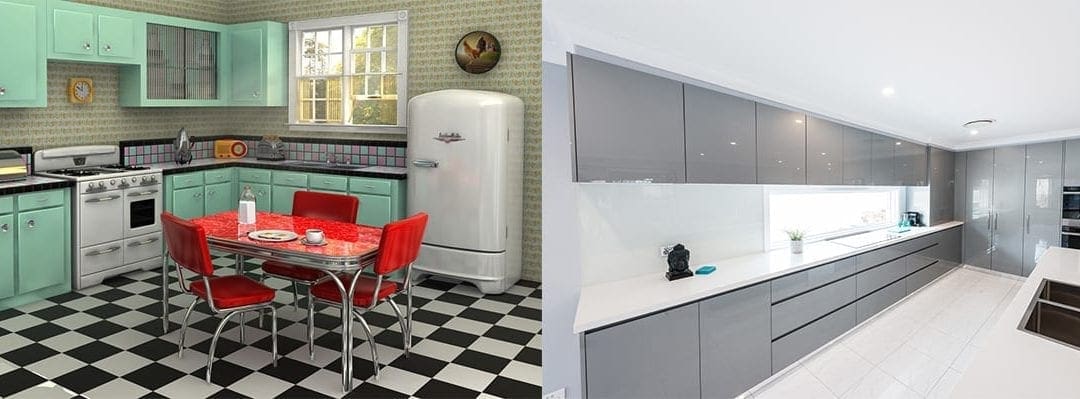You’re thinking, “That can’t be right. How can a kitchen almost 70 years old, be modern?” Well, guess what? It is.
In the world of home design, the terms modern and contemporary are often used interchangeably. In fact, they are not the same thing. Particularly when it comes to kitchen design, it is not uncommon to have a modern kitchen that also features some contemporary influences. In the same way, it is also possible to have a traditional kitchen that includes some modern or contemporary elements.
So, what is the difference between a modern kitchen and a contemporary kitchen?
Contemporary = right now
Contemporary is used to refer to themes and trends that are of the current moment. Anything that is new and different from what has come very recently before or is generally considered “trendy” is said to be contemporary. A contemporary kitchen may well include some influence from other kitchen design styles too, but it may not necessarily be applied in a way that has been regularly seen or done before. Basically, a contemporary kitchen is anything that is built or styled in the present day and draws on emerging trends as well as the owner’s unique style and expression to create something truly unique and often “outside the square”.
Where do modern kitchens come from?
It may seem hard to believe, but it is true that not a lot about the foundations of a current day kitchen have changed much since the kitchens of the 1950s. And so a modern kitchen is said to be a kitchen that takes its cues from the kitchen evolution that was taking place around this time and the years that followed.
In the beginning…
Once upon a time cooking was done over an open fire and water was brought in from a well. By the 1940s most kitchens had sinks and gas cooktops and the post-war era of the 1950s saw the emergence of, and transition towards, what very closely resembles many kitchens of today. This was the time that kitchens went from being a small work-horse room purely dedicated to producing family meals and usually tucked away out of sight, to earning a spot as a stylish, functional and respected part of the home, that was to be celebrated and shared. Integrated cabinetry and built-in appliances started to make an appearance and while at this time most kitchens were still located in a separate room or area, the notion of an open plan area was in its infancy.
The idea of the “kitchen triangle” also surfaced around this time as kitchen layouts became more functional and efficient.
Same, same, but just a little different
So while the materials from those early modern kitchens may have changed a little to the modern kitchen of today – from steel cabinetry, linoleum flooring and laminate benchtops to polyurethane coated timber doors, tiled or hardwood floors and stone benchtops – the essential elements remain the same. And this is the premise of the modern kitchen.
And then what happened?
As time went on, we saw the size of kitchens, and their storage capabilities, increase to accommodate for the increasing amount of pots, pans and electrical appliances that were making their way into homes. It became a status symbol to have a well-stocked kitchen, and it was not something to be shy about.
The way that homes and kitchens were being used was changing too and so the idea of an open plan kitchen became more mainstream as it created a space for not only cooking but for the family to spend time together and also entertain guests.
The addition of the kitchen island bench, and some shuffling and adjusting of the traditional “kitchen triangle” to allow for a more efficient work and traffic flow through this newly designed space, complete the modern kitchen as we know it.
Modern kitchens of today
Today’s modern kitchen exhibits all the characteristics of the modern kitchens that came before it. But that doesn’t mean that they all have the same design style or visual aesthetics.
For example, it is possible to have a new kitchen built in a French Provincial or Hamptons style, that incorporates a majority of the design features inherited from the modern kitchen. This approach makes it possible to combine a traditional visual style and yet make the kitchen suitable for modern day living.
The modern kitchen design style
There are, however, some design features that in more recent times, have become known as familiar with overall modern kitchen design.
A flat panel door style along with frameless or full-overlay cabinet construction is one such feature that is typical of a truly modern kitchen aesthetic. There is often little to no ornamentation or embellishment in a modern kitchen, but that doesn’t mean that it is by any means boring. Modern kitchens tend to have a focus on clean horizontal lines and a minimalist approach to sleek and simple hardware is an extension of that. Modern kitchens also tend to make use of natural materials as feature items and any accent décor or design pieces are usually very consistent in style as opposed to the more eclectic and some might say “mismatched” items that you are likely to find in a contemporary kitchen.
The wrap-up
There you have it. A kitchen can be both modern and contemporary, or traditional as well as modern and/or contemporary too. The options are only limited by your imagination, but there is definitely plenty of inspiration out there.
The team of designers at Harrington Kitchens have worked with our valued clients to create kitchens of many different styles and we certainly understand the demands of a modern day kitchen. Contact our team on 1300 662 112, submit an online enquiry or visit us at our Narellan or Bowral showrooms to discuss how we can make your dream kitchen a reality.


Recent Comments